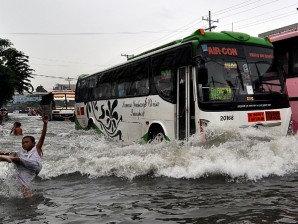TAGAYTAY CITY—Be a citizen-weatherman.
The Philippine Atmospheric, Geophysical and Astronomical Services Administration (Pagasa) is asking Metro Manila residents to text them reports of thunderstorms and flooding in their areas to help create a more comprehensive flood warning system.
Raymond Ordinario, a Pagasa weather specialist, urged Metro residents to serve as citizen-weather reporters by sending flood situation reports to 09062317659.
Ordinario said the agency’s Doppler radar and rain gauges were not enough for its color-coded Rainfall Warning System.
Under the system, Pagasa issues three color-coded weather advisories.
A yellow alert means the public should be vigilant because moderate to heavy rains have fallen for the last two hours and are expected to continue for up to three hours more.
An orange alert means the public should prepare for flooding because heavy to intense rain have fallen for the last two hours and are expected to continue for two to three hours more.
A red rainfall advisory is issued alert residents that flooding is imminent in low-lying areas that would require emergency evacuation.
“We will be using the (citizen) reports for cross validation with the data that we get from the radar and rain gauges,” Ordinario said at a National Disaster Risk Reduction and Management Council conference.
“So instead of spreading spam, they can just text us and do a public good,” he added.
He explained that while the Doppler radar can show where rain clouds are heavily concentrated, it cannot show if rain was actually falling in that place.
“We would need someone on the ground for that,” Ordinario said.
He added that the results of rain gauges could also be distorted by pollutants in the rain water and other factors.
Ordinario said a citizen-weatherman could report if there is flooding in their area and how high it is.
Ordinario said the reports of citizen weathermen would be of great help to the color-coded Rainfall Warning System in the National Capital Region.
Ordinario said the system is being implemented in Metro Manila but would also soon cover Central Luzon and Southern Tagalog.
“We still need to tweak the system for these other places because a 30 mm rain would mean flooding in Metro Manila but not in Nueva Ecija,” Ordinario said. “You have to consider local factors like topography and land use,” he added.
